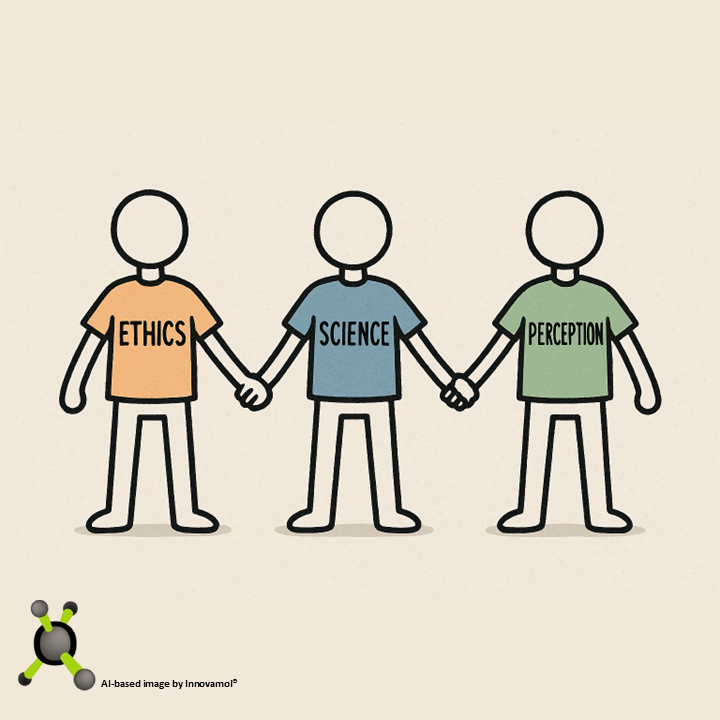Public awareness of lab-grown meat has reached an all-time high. For instance, a very recent report from the FSA found that 79% of UK respondents were aware of the term in April 2025, up from 72% in October 2024. Yet familiarity doesn’t always translate into acceptance: fewer than one in three (28%) would be willing to include it in their diet, and an even smaller share (32%) believes it should be available for sale. These figures reveal a paradox, one in which recognition grows, but doubt lingers. In fact, if cultivated meat is to become more than a technological curiosity, the public must understand not only what it is—but how it’s made, why it matters, and whether it’s safe and appetible. Near the futuristic headlines lies a story of stem cells, bioreactors, ethics, and perception—a blend of biology and belief that could reshape our food system from the inside out.
Basically, stem cells, which are usually separated from muscle tissue, are the starting point for cultivated meat. These cells can multiply and, in the correct circumstances, differentiate into muscle fibres and fat cells, which are the main ingredients of what we traditionally refer to as meat. The growth and differentiation procedure takes place in bioreactors, which carefully regulate temperature, pH, oxygen, and nutrients to replicate the growth conditions found inside an animal’s body. However, this cellular agriculture offers a level of precision never seen before in food production, in contrast to traditional livestock farming. It’s meat with a molecular footprint, not just meat.
One of the most persistent questions is whether this is truly scalable. In a technical sense, it is. As researchers have pointed out, the number of cells required to feed a population—even a country—is astronomically high, but theoretical models suggest it’s feasible. The cells divide rapidly and can be guided into forming the desired tissue structure. Yet the scientific challenge lies not only in quantity, but in quality. Texture, taste, and structure remain difficult to reproduce without tools like scaffolding or 3D bioprinting, which are still evolving. What can be produced reliably today is closer to a minced or processed product than a marbled steak.
In addition, safety is a major concern from a biological, regulation, and psychological standpoint. Cultivated meat is subject to a stringent authorisation process overseen by the European Food Safety Authority (EFSA) because it is categorised as a “novel food” in the EU. This includes evaluations of manufacturing procedures, possible contaminants, allergenicity, and nutritional composition (https://www.efsa.europa.eu/en/topics/topic/novel-food). Crucially, a lot of the same hazards that are present in traditional food, like contamination or residues, also exist here but can be reduced with the right controls and closed systems. Effective communication, independent science, and transparent regulation are necessary for public trust, though.
But even if the science is sound, perception is another matter. Cultivated meat occupies a curious space in the human imagination. For some, it represents a triumph of ethics and innovation—a way to enjoy meat without the suffering of animals or the emissions of industrial farming. For others, it feels unnatural, sterile, even repellent. Emotions such as disgust are often cited, and while visceral, they are not always rational. Much of the resistance to cultivated meat is grounded in deeply held narratives about what food should be—natural, traditional, unmediated by science. Yet our current food system is anything but natural. Industrial livestock farming relies on antibiotics, hormone treatments, and monocultures. If cultivated meat is artificial, then so is much of what fills our supermarket shelves.
From a psychological perspective, consumer acceptance is shaped by a complex mix of values, awareness, and identity. People are more open to novel foods when they understand the science, feel a moral alignment, or associate them with environmental benefits. But they are also hesitant when foods challenge cultural norms or seem too abstract. Studies show that young people, urban residents, and those with higher education levels are generally more receptive (https://gfieurope.org/blog/consumer-acceptance-cultivated-meat/), yet even they may struggle to integrate the idea into daily choices. The challenge, then, is not just to develop a better food product—but to redefine what we mean by “better”.
Ethically, cultivated meat disrupts familiar debates. It appeals to those concerned with animal rights, environmental degradation, and resource use. But it also raises its own questions. Is it just a workaround that lets us avoid deeper behavioural change? Does it commodify life in a new way? Can it be truly democratic if it remains expensive or proprietary? Philosophers have long debated whether moral progress comes from better tools or better choices. Perhaps cultivated meat, as a tool, can help unlock both.
In the end, the promise of cultivated meat lies not only in its technical plausibility, but in its narrative power—its ability to invite society to think differently about what we eat, how it’s made, and who gets to decide. The science is advancing, the ethics are evolving, and the public is watching. What happens next will depend as much on trust and transparency as it does on cell lines and bioreactors.
“Every great advance in science has issued from a new audacity of imagination” – John Dewey

